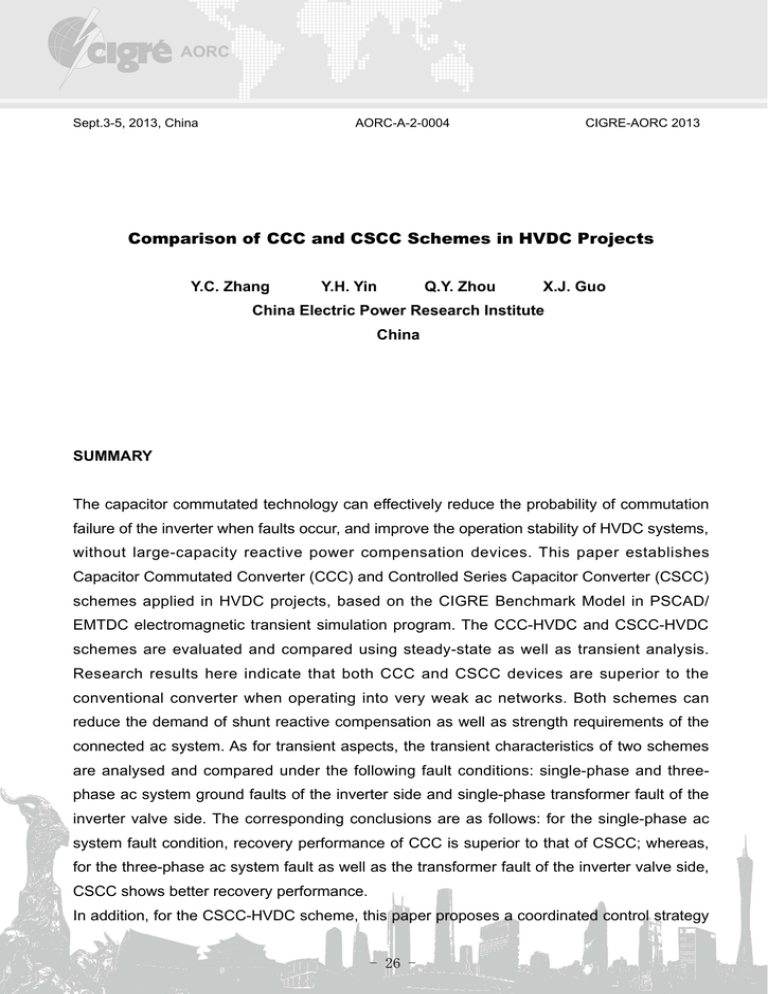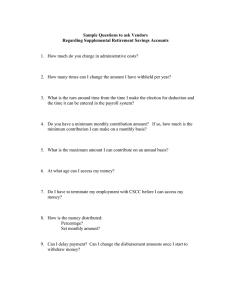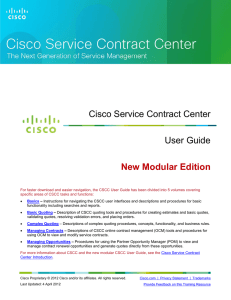Comparison of CCC and CSCC Schemes in HVDC Projects
advertisement

Sept.3-5, 2013, China AORC-A-2-0004 CIGRE-AORC 2013 Comparison of CCC and CSCC Schemes in HVDC Projects Y.C. Zhang Y.H. Yin Q.Y. Zhou X.J. Guo China Electric Power Research Institute China SUMMARY The capacitor commutated technology can effectively reduce the probability of commutation failure of the inverter when faults occur, and improve the operation stability of HVDC systems, without large-capacity reactive power compensation devices. This paper establishes Capacitor Commutated Converter (CCC) and Controlled Series Capacitor Converter (CSCC) schemes applied in HVDC projects, based on the CIGRE Benchmark Model in PSCAD/ EMTDC electromagnetic transient simulation program. The CCC-HVDC and CSCC-HVDC schemes are evaluated and compared using steady-state as well as transient analysis. Research results here indicate that both CCC and CSCC devices are superior to the conventional converter when operating into very weak ac networks. Both schemes can reduce the demand of shunt reactive compensation as well as strength requirements of the connected ac system. As for transient aspects, the transient characteristics of two schemes are analysed and compared under the following fault conditions: single-phase and threephase ac system ground faults of the inverter side and single-phase transformer fault of the inverter valve side. The corresponding conclusions are as follows: for the single-phase ac system fault condition, recovery performance of CCC is superior to that of CSCC; whereas, for the three-phase ac system fault as well as the transformer fault of the inverter valve side, CSCC shows better recovery performance. In addition, for the CSCC-HVDC scheme, this paper proposes a coordinated control strategy - 26 - based on a constant equivalent short circuit ratio(ESCR) of the interconnected ac/dc power system. By modeling and simulation of the control strategy in PSCAD, its correctness and effectiveness is verified. KEYWORDS HVDC, Capacitor Commutated Converter (CCC), Controlled Series Capacitor Converter (CSCC), Coordinated Control Strategy. 1 Introduction The conventional line commutated converter(LCC) used in HVDC transmission relies on the ac bus voltage for the commutation process. It means that the coming valve must be triggered sufficiently in advance of the line-line voltage zero crossing to provide sufficient commutation margin after the end of the overlap period[1]. The reliance on line voltage for commutation also makes the converter susceptible to commutation failure in the event of ac system voltage sag and integrating into weak ac systems is particularly difficult. The capacitor commutated technology can effectively reduce the probability of commutation failure of the inverter when faults occur, and improve the operation stability of HVDC systems, without large-capacity reactive power compensation devices. The capacitor commutated converter(CCC), as well as the controlled series capacitor converter (CSCC) , are two kinds of artificial commutated converters using series capacitors, which have been proposed to remedy some drawbacks of the conventional LCC. Their topologies are shown schematically in Figs. 1 and 2, respectively. Fig. 1. Capacitor Commutated Converter - 27 - Fig. 2. Controlled Series Capacitor Converter In reference[1], a detailed comparison of CCC and CSCC options are made with respect to the steady state and transient performance. Reference[2] compares the features and dynamic performance of series compensated and classic HVDC converters in long cable transmission. It also analyzes different ways of the location of the TCSC and the ac harmonic filters. Reference[4] analyzes the valve commutation process of CCC and shows the concerned fault perfrormance. References[5,6] proposes the control strategies and the modeling of CCC, respectively. Reference[7] describes the benefits and drawbacks of applying CSCC for wave energy conversion(WEC) buoys. This paper establishes CCC and CSCC schemes applied in HVDC projects, based on the CIGRE Benchmark Model in PSCAD/EMTDC electromagnetic transient simulation program. The CCC-HVDC and CSCC-HVDC schemes are evaluated and compared using steadystate as well as transient analysis. In addition, for the CSCC-HVDC scheme, this paper proposes a coordinated control strategy of the CSCC, based on a constant equivalent short circuit ratio(ESCR) of the interconnected ac/dc power system. By modeling and simulation of the control strategy in PSCAD, its correctness and effectiveness is verified. 2 Features of CCC and CSCC Schemes A. Capacitor Commutated Converter The CCC technology has previously been suggested as a way of obtaining self-commutated converters[2]. The capacitor is placed on the valve side of the converter transformer to decrease the possibility of ferroresonance problems. It has the following advantages[1,8]: 1) Its capability of providing reactive power compensation can be utilized to give a reactive power characteristics less dependent of the active power flow changes. This also eliminates - 28 - the huge need for capacitive shunt banks in converter stations, which can in turn lower the overvoltage of sudden load shedding conditions. Here, the ac filters are chosen only for harmonic filtering requirements and their Mvar rating can be reduced to very small values. 2) The location of the commutated capacitors, between the converter transformer and the valve bridge, results in a lower phase-to-phase voltage on the valve side of the transformer. This means a reduced reactive power flow through the transformer and its rating can be smaller compared to that of the LCC scheme. 3) High immunity to ac network disturbances is gained, for the commutation capacitors can be regarded as an extra source of the commutation voltage in addition to the ac bus voltage. Thus, a larger commutation margin may be maintained when faults occur. 4) The commutated capacitor reduces the valve short-circuit currents due to the voltage drop across the capacitor varistors, which are installed in parallel in a compact CCC configuration. B. Controlled Series Capacitor Converter The CSCC scheme can be preferably described as an amalgamation of the conventional LCC and the TCSC technology. Ferroresonance problems may be avoided, since the capacitance is changed by the control of thyristors. As for the relative location of the TCSC and ac filters, a theoretical evaluation demonstrates that ac filters should be located between the converter transformer and the TCSC, which can offer the best operation performance[2]. Also, the TCSC will not be exposed to harmonics from the valve side. Similarly, the CSCC scheme has advantages over the conventional LCC in aspects of less reactive power compensation, higher immunity to ac faults, better operational stability connecting weak ac systems, etc. In addition, one advantage superior to the CCC scheme is that the converter itself is of the conventional Graetz bridge configuration, which will not lead to a higher voltage stress on the valve. Moreover, a crucial feature of the TCSC here is its inherent damping of sub-synchronous oscillations[3]. 3 Operation Characteristics of CCC and CSCC Schemes A. Steady-state performance Based on the CIGRE Benchmark Model, the parameters of its ac system of the inverter side are modified while the remaining parts stay the same. The short-circuit ratio(SCR) is changed to 1.5, smaller than its critical value. Then the operation performance of the LCC, CCC and - 29 - CSCC schemes is compared in Fig. 3. (a) LCC (b) CCC (c) CSCC Fig. 3. Operation curves of LCC, CCC and CSCC As seen from the above figures, the LCC scheme can`t maintain stable operation while the CCC and CSCC can still operate in normal ways. Thus, it can be safely concluded that both CCC and CSCC schemes have better performance when feeding a weak ac system. B. Transient performance In this section the CCC and CSCC schemes are compared with respect to their performance under the following transient conditions: single-phase and three-phase ac system ground faults of the inverter side and single-phase transformer fault of the inverter valve side. Fig. 4 respectively shows dc voltage, dc current, rms ac bus voltages of the rectifier and the inverter under the above fault conditions. All faults are applied at 2.5s into the run and have a 5 cycle duration. (a) Single-phase ac ground fault (b) Three-phase ac ground fault (c) Single-phase transformer fault Fig. 4. Fault simulation waveforms of CCC and CSCC - 30 - From Fig. 4(a), The CCC scheme exhibits a more smooth ramp of the dc voltage during the fault. The peak overcurrent is relatively a little lower in the CCC scheme. Meanwhile, the rms ac voltages of both the rectifier and inverter sides own better recovery performance in the CCC scheme. Obviously, the dc voltage recovery of the CSCC scheme is faster than that of the CCC scheme, and the same is with the dc current in Fig. 4(b). The rms ac voltages also show better transient performance in the CSCC scheme. The reason can be briefly explained like this: the variable capacitance of the CSCC scheme results in better response to the fault condition, thus, it can ride through the fault faster. As shown in Fig. 4(c), the trough value of the dc voltage in the CSCC scheme is lower than that of the CCC scheme, whereas, the CSCC shows a better recovery speed. Also the rms ac voltages in the CSCC scheme have smaller oscillations during the period, which will in turn accelerate the recovery rate. 4 Coordinated Control Strategy of CSCC In this paper a coordinated control strategy of the CSCC scheme is proposed, based on a constant equivalent short circuit ratio(ESCR) of the interconnected ac/dc power system. The control strategy can be briefly explained as follows: the actual short circuit ratio(SCR) can be obtained by the inherent system parameters. Then a comparison between the actual SCR and the given SCRref is made: if SCRact is smaller than SCRref, the CSCC will be put into operation; otherwise it is blocked and the inverter turns into the LCC actually. When the CSCC is in operation, its capacitance is determined by the SCRref. The following part can be regarded as a constant impedance control model of CSCC, in which PI controllers are used to generate thyristor trigger signals. Since the capacitance should be adjusted in a restrained range, the output of PI controllers undergoes an amplitude -limiting section before its access to the thyristor trigger generator. By modeling and simulation of the control strategy in PSCAD, its correctness and effectiveness is verified. The model is schematically shown in Fig. 5. - 31 - C Lines SCR LCC operation Graetz bridge L no SCR <SCRref yes CSCC operation Zmes Kp ZCSCC Calculate + ZCSCC = f(SCRref) + — ∑ PI controller ∑ Kg + Ki/s Trigger generator Amplitude-limiting section Fig. 5. CSCC control scheme 5 Conclusions Research results here indicate that both CCC and CSCC devices are superior to the conventional converter when operating into very weak ac networks. The CCC and CSCC schemes can reduce the demand of shunt reactive compensation as well as strength requirements of the connected ac system. As for transient aspects, the corresponding conclusions are as follows: for the single-phase ac system fault condition, recovery performance of CCC is superior to that of CSCC; whereas, for the three-phase ac system fault condition as well as the transformer fault condition of the inverter valve side, CSCC shows better recovery performance. In addition, for the CSCC-HVDC scheme, this paper proposes a coordinated control strategy based on a constant ESCR of the interconnected ac/dc power system. By modeling and simulation of the control strategy in PSCAD, its correctness and effectiveness is verified. BIBLIOGRAPHY [1] K. Sadek, M. Pereira, D.P. Brandt, et al. “Capacitor Commutated Converter Circuit Configurations for DC Transmission”(IEEE Transactions on Power Delivery, Vol. 13, No. 4, October 1998, pages 1257-1264) [2] Tom Jonsson,Per Holmberg,Thomas Tulkiewicz. “Evaluation of Classical, CCC and TCSC Converter Schemes for Long Cable Projects”(Swizerland, September 1999) [3] Ahlgren K, Holmberg D, Halvarsson P, et al. “Thyristor controlled series capacitor used as a means to reduce torsional interaction subsynchronous resonance”(Cigre SC14 Colloquium on HVDC and FACTS in South Africa,1997) - 32 - [4] Angelo J.J. Rezek, Adriana A, et al. “The capacitor commutated converter(CCC) as an alternative for application in HVDC projects”(Industrial Electronics, Vol. 1, 2003, pages 432437) [5] M. Meisingset, A.M. Gole. “Control of capacitor commutated converters in long cable HVDC-transmission”(Power Engineering Society Winter Meeting, Vol. 2, 2001, pages 962967) [6] Sergio Gomes, Nelson Martins, et al. “Modeling Capacitor Commutated Converters in Power System Stability Studies”(IEEE TRANSACTIONS ON POWER SYSTEMS, Vol. 17, No. 2, May 2002, pages 371-377) [7] D. Kalpaktsoglou, V. Pickert. “Controlled Series Capacitor Converters Applied to Wave Energy Conversion Buoys—A Simulation Study”(PEMD 2008. 4th IET Conference, pages 396-400) [8] Guibin Zhang, Zheng Xu.“The New Development of HVDC Technology”( Electric Power, Vol. 33, No. 3, 2000, pages 32-35) Short Bio-data of Main Author Y.C. Zhang was born in Shanxi, China, on Mar. 14, 1989. She received the B.S. degree in Electrical Engineering from Xi`an Jiaotong University, Xi`an, China in 2011. She is now a postgraduate of China Electric Power Research Institute (CEPRI). Her research interest includes power system planning, operation and HVDC transmission control. - 33 -




